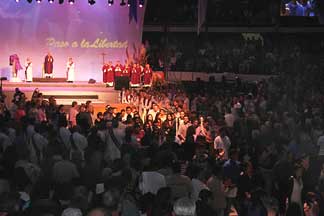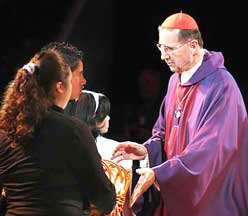Migrant Watch
Filipino Priests Flock to U.S.
As the U.S. Catholic
Church opens its doors to Filipino priests, this situation causes a “brain
drain” of sorts in the Philippines. Priests and seminarians go to the
U.S., attracted by a package of relocation, scholarships and other perks.
BY NICANOR SEGOVIA
Bulatlat

The Elect process out
of the Arena during the Religious Education Congress' closing liturgy
April 2 for reflection on the Scriptures.
Photo by LISA M. DAHM |
ANAHEIM, California –
Some 20,000 Catholic parishioners had their eyes focused on the liturgy of
prayer, music and dance that capped the four-day yearly religious
education congress at the Arena, main annex of the huge Convention Center
here just right beside the
Disneyland. For two hours, in the
afternoon of April 2, the faithful – among them Filipinos – responded to
what appeared to be a well-scripted liturgy, listening to the homily of
Cardinal Roger Mahony with his image caught by two giant video screens.
The cardinal, who also spoke in Spanish, has recently got the flak from
conservatives and rightists for supporting immigrant rights. |
Assisting the
cardinal were about 15 bishops from California who also led the rites
welcoming about 50 members of the “Elect” (new Catholic converts), some of
them Latinos and a few Asians and Arabs. As the mass participants raised
their hands toward them, the converts were received with a solemn prayer
asking God to forgive them for their sins. Just the same, the pomp and
pageantry and the scintillating orchestral music somewhat drowned out the
religiosity of the whole liturgy.
What struck any
parishioner, however, is the prayer incantation by an ensemble of
performers in Italian, Spanish, English, Vietnamese, Chinese – and
Pilipino. Among the bishops was Oscar Solis, appointed by the Vatican in
late 2003 as the first Filipino-American bishop of the U.S. Catholic
Church. The archdiocese of Los Angeles, which he heads, sponsored the
religious education congress. With five million members, the archdiocese
is the second largest in the U.S. The presence of Solis, who hails from
Nueva Ecija, inside the modern, circular Arena and that of the big
Filipino flock dramatized the increasing role of the Filipino ministry in
the U.S. Catholic Church.
Sex scandals
The U.S. Catholic
Church continues to be wracked by sexual molestation charges thrown
against many priests, causing its credibility particularly in the east
coast to slip to its lowest. As a result, a significant number of
Catholics have left the church.
Meantime, while the
number of cases in child sex abuse went down to 783 in 2005, dioceses,
eparchies and religious communities paid out $465 million to settle the
charges, $309 million more than in 2004 when there were 1,092 cases. Since
1950, the U.S. church – the richest in the world – has paid more than $1.3
billion on clergy sex abuse-related cases, mostly in settlement to
victims, including Filipinos.
Allegations of child
abuse, which have dragged even a cardinal in Chicago for his alleged
complacency, aggravated the shortage of parish priests in the Catholic
Church. In the first half of 2002 alone, about 300 of the 46,000 U.S.
priests were relieved of their mission over abuse allegations. On the
other hand, many long-time American priests are retiring and recruitment
of younger ones is slow. So critical has the scarcity of priests become
that in many dioceses some pastors serve two or more parishes. More and
more diocese offices are now occupied by lay persons.
The strong position
taken by the U.S. Conference of Catholic Bishops (USCCB) against the House
immigration bill that criminalizes some 13 million “undocumented
immigrants” may yet repair the credibility damage suffered by the church.
Whether this will heal the wound and eventually attract recruits to the
clergy, however, is yet to be seen.
From Asia and
Pacific
For these reasons,
the U.S. Catholic hierarchy appears to be counting on the hiring of
priests from Asian and Pacific countries – or nationals with the same
regional heritage who are born in the United States - so that their church
can continue to perform its role and even survive.
|
Among priests
originating from Asia and the Pacific islands, Filipinos account for the
biggest group, followed by Vietnamese, Indians, Chinese and Koreans. About
40 Filipino priests serve in one diocese alone in California where there
are more than one million Filipino-Americans, at least 85 percent of them
Catholics. Ten years ago, there were about 300 Filipino priests, brothers
and deacons and 200 nuns in the United States. At present, there should be
at least 500 Filipino priests, a Filipino pastor said.
Likewise, in any
given year, several hundreds more come to the U.S. as “visiting priests.”
They are joined by many Filipino missionaries who leave their
congregations in Africa, Latin America and other regions and come to the
U.S. to be incarnated for a new mission.
|

Cardinal Roger Mahony
accepts bread and wine during the presentation of gifts at a Congress
liturgy.
Photo by LISA M. DAHM |
Many Filipino priests
have been appointed pastors, while Filipino laypersons have been chosen
Catholic school principals or assigned to diocesan chanceries. Many of
them lead Filipino ministries where large numbers of their compatriots are
found such as in California, Hawaii,
Illinois, New York,
New Jersey, Washington,
Virginia, Texas,
Florida, Ohio
and Maryland. A big percentage of the priests eventually become U.S.
citizens.
The U.S. church
readily takes in Asian and Pacific priests for yet another reason.
Supposedly, they embody the values that Catholicism or the church
organization claims to represent today, among them protecting the family,
youth education, campaign against human or sex trafficking and giving
sanctuary to immigrants and the homeless.
“Brain drain”
As the U.S. Catholic
Church opens its doors to Filipino priests, this situation causes a “brain
drain” of sorts in the Philippines. Aside from priests, Filipino
seminarians are also enticed to come with U.S. churches promising to work
on their immigration papers and air fare as well as scholarships in
American universities where they can finish their theology courses. But
the whole package also includes other perks - housing, allowances and a
car, to name a few. Some U.S. Catholic churches send representatives to
the Philippines for direct recruitment.
One of the “push”
factors, according to a Bulatlat source, is that the Catholic
Church in the Philippines has no retirement plan for old priests. Without
any savings at all after dutifully ministering to their flock for decades,
retiring priests are embraced back by their relatives until they die.
Recently though, in
light of the 9/11 incident, some restrictions to priests coming to the
U.S. have been put in place. The new rules include an official invitation
by a U.S. bishop, among others.
Priests and
seminarians from the Philippines – as well as from Vietnam (those who are
largely born to Vietnamese expatriates in the U.S.), Taiwan and South
Korea – tend to address the shortage of parish priests here. But this
exodus leaves a shortfall of Catholic priests in these countries as well.
For instance, the Catholic Bishops Conference of the Philippines (CBCP)
estimates that there is a shortage of 25,000 priests. Bulatlat
BACK TO
TOP ■
PRINTER-FRIENDLY VERSION ■
COMMENT
© 2006 Bulatlat
■
Alipato Publications
Permission is granted to reprint or redistribute this article, provided
its author/s and Bulatlat are properly credited and notified.